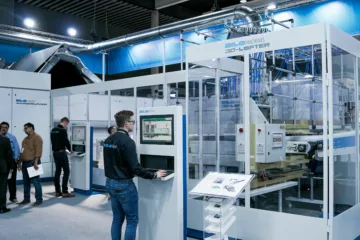Why Manufacturers Should Invest in Efficiency via Digital Transformation
Manufacturers today face increasing pressure to improve
productivity while reducing costs and waste. Digital transformation
offers a clear path to achieving these goals by embedding advanced
technologies like IoT, AI, and automation into existing workflows. Investing in digital efficiency is essential for staying competitive, enhancing product quality, and streamlining operations.
By adopting these technologies, we can reduce manual tasks,
optimise resources, and respond faster to market demands. The
integration of smart systems also improves decision-making through
real-time data, driving continuous improvement across the production
process.
As manufacturers, embracing digital transformation is no longer
optional but necessary to navigate the challenges of modern industry and
secure long-term success. This article explores why focusing on
efficiency through digital tools is a strategic investment worth making.
The Strategic Advantages of Digital Efficiency
Investing in digital efficiency allows us to optimise production,
make informed decisions based on real-time data, and differentiate
ourselves in a highly competitive market. This strategic approach helps
us meet growing customer demands and drive operational excellence
without sacrificing quality.
Enhanced Productivity and Throughput
Digital transformation introduces automation and advanced
technologies that streamline repetitive tasks. By integrating IoT
devices and AI systems, we reduce manual intervention, minimise errors,
and speed up production cycles.
This leads to higher throughput with consistent quality. For
example, predictive maintenance prevents unplanned downtime by
identifying equipment issues early, keeping lines running smoothly. We
also gain flexibility, enabling us to efficiently handle smaller batch
sizes and more product variants without losing efficiency.
Increased productivity directly affects our bottom line by
lowering operational costs and improving resource use. Adopting these
technologies ensures we maintain steady output even under fluctuating
demand.
Data-Driven Decision Making
Digital systems collect vast amounts of operational data in real
time. Analysing this data allows us to understand process bottlenecks,
track material usage, and monitor equipment health precisely.
Using AI and machine learning tools, we can predict trends and
optimise scheduling, inventory, and supply chains. This reduces waste
and avoids overproduction. Accurate insights also help us respond
quickly to market changes or issues on the shop floor.
Data-driven decision making transforms reactive management into
proactive strategies. It enhances transparency across departments,
making collaboration and accountability clearer and more effective.
Competitive Differentiation
Leveraging digital efficiency sets us apart in a crowded
marketplace. Manufacturers who adopt advanced technologies can deliver
higher quality products faster and at lower costs.
Our ability to innovate processes and personalise production
aligns with evolving customer preferences for customisation and speed.
Digital tools also improve compliance with quality and safety standards,
strengthening our reputation.
Moreover, embracing digital transformation positions us as leaders
ready for Industry 4.0. This forward-looking approach attracts
partnerships and investment opportunities, supporting long-term growth
and resilience.
Reducing Operational Costs and Waste
Investing in digital transformation lets us streamline processes
and make better use of materials, time, and equipment. This directly
reduces expenses linked to inefficient resource use, unexpected
downtime, and equipment failure.
Optimisation of Resource Utilisation
By digitising data collection and analysis, we can pinpoint areas
where resources are wasted. Technologies like IoT sensors track raw
material usage in real time, helping us avoid overproduction and surplus
inventory.
Using digital tools, we adjust production schedules dynamically to
match demand precisely. This reduces material waste and excess energy
consumption, lowering costs. Automated systems also help balance labour
and machine time efficiently, ensuring we get the most output from
inputs.
Minimisation of Downtime
Digital transformation gives us full visibility of the production
line, enabling quicker identification of bottlenecks or issues. With
real-time monitoring, problems can be detected and addressed before they
cause significant delays.
Automation also shortens setup and changeover times between
production runs. Smart scheduling tools coordinate maintenance and
production tasks to avoid unnecessary halts, keeping operations running
smoothly and reducing losses related to idle time.
Predictive Maintenance
We use AI and machine learning models to analyse sensor data from
equipment, predicting failures before they happen. This allows us to
schedule maintenance precisely, preventing costly unexpected breakdowns.
Predictive maintenance reduces unnecessary servicing, saving
labour and parts costs. It also extends machinery life by ensuring
timely intervention. This proactive approach keeps production consistent
and prevents waste caused by sudden interruptions.
Empowering Workforce and Strengthening Collaboration
To drive efficiency in manufacturing, we must focus on enhancing
our workforce’s skills and enabling seamless communication. Both
training and real-time collaboration tools play essential roles in
maximising productivity and adapting to digital transformation’s
demands.
Skills Development and Training
Upskilling workers is critical given the rapid introduction of
technologies like AI, IoT, and cobots. We need to invest in tailored
training programmes that address specific roles and technologies,
ensuring employees remain competent and confident.
Collaborations with educational institutions can support
continuous learning and talent influx. We should provide hands-on
training, digital literacy courses, and opportunities for
cross-functional skills growth to maintain a flexible workforce capable
of adapting to change.
Regular skills assessment helps identify gaps and target
development efforts. Prioritising knowledge transfer between experienced
and less-experienced workers supports a sustainable skill base,
especially as many manufacturers face an ageing workforce.
Real-Time Communication Tools
Implementing real-time communication platforms enhances
decision-making and quick problem-solving. Tools such as instant
messaging, video conferencing, and digital dashboards create
transparency and connect shop floor teams with management instantly.
These technologies reduce delays caused by information silos and
paperwork. They enable workers to report issues, share updates, and
coordinate workflows efficiently, improving overall operational
responsiveness.
We must focus on integrating these tools with existing systems to
ensure smooth adoption. Training on effective use and encouraging
openness in communications will empower teams to collaborate
proactively, driving continuous improvement.
Future-Proofing Manufacturing Operations
We must focus on building manufacturing operations that can grow
and change without losing efficiency. At the same time, meeting
environmental responsibilities is essential to ensure long-term
viability and compliance with evolving regulations.
Scalability and Adaptability
Our manufacturing operations need to scale seamlessly as demand
changes. Digital transformation enables us to integrate flexible,
modular systems that handle varying production volumes without costly
downtime or reconfiguration.
By connecting IT with operational technologies, we create a
unified infrastructure that supports real-time data sharing. This
integration allows rapid adjustments to processes, optimising resource
use and reducing waste.
Automation and cloud computing offer scalable solutions that grow
with our needs. This avoids overinvestment in fixed assets and ensures
we can swiftly adopt new technologies or methods.
Sustainability Commitments
We face increasing pressure to reduce environmental impact while
maintaining productivity. Digital tools help us monitor and manage
energy consumption, waste, and emissions more precisely than traditional
methods.
Implementing data-driven sustainability practices allows us to
meet regulatory requirements and improve resource efficiency. For
example, predictive analytics can identify inefficient equipment before
failure, reducing downtime and energy waste.
Incorporating sustainable principles into digital transformation
supports both long-term cost savings and brand reputation. Aligning our
digital upgrades with sustainability goals strengthens our commitment to
responsible manufacturing.

